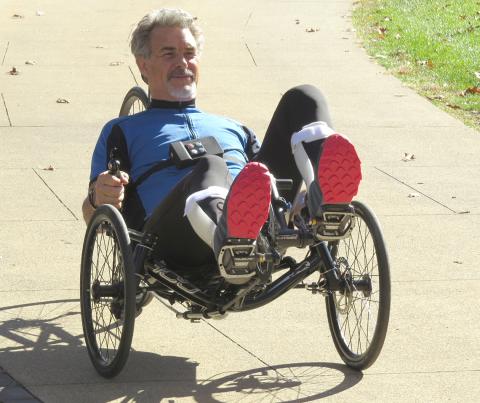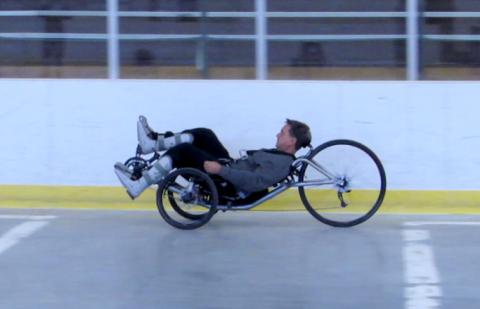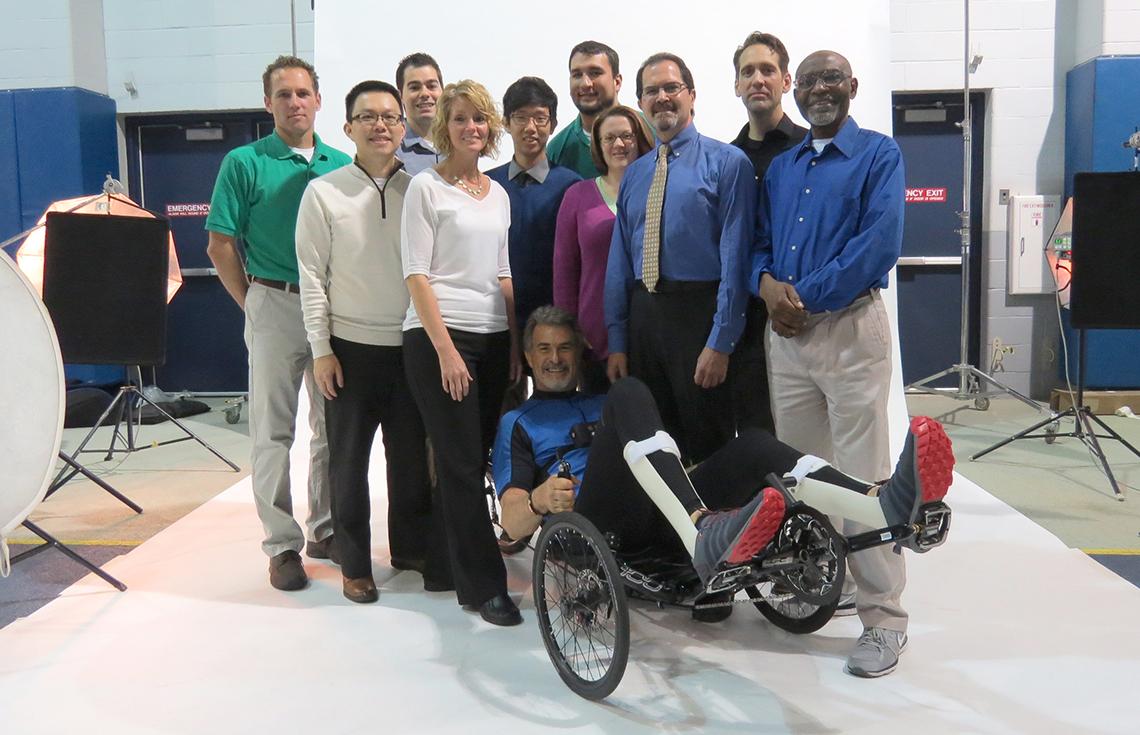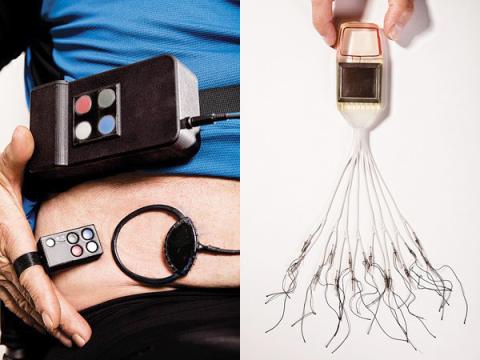Olympic-Style Competition To Showcase Use of Advanced Assistive Devices

Photo: Nathaniel Welch
While much of the world’s attention this past summer was on the Olympic Games in Rio de Janeiro, a small team from Cleveland has had their eyes set on a fundamentally different kind of athletic competition for human-machine teams. This first-of-its-kind event, the international Cybathlon, features contests for people with disabilities using assistive technologies and will take place Oct. 8 in Zurich, Switzerland. Team Cleveland has entered the functional electrical stimulation bike race.
Though paralyzed by a spinal cord injury, the Team Cleveland cyclist will use power generated by his own leg muscles to pedal for gold around a 750-meter oval course. He will control a system that activates his muscles using electronic pulses. Researchers developed the implanted stimulation system with support from the National Institute of Biomedical Imaging and Bioengineering. This bionic system will enable the cyclist to pilot a three-wheeled recumbent cycle in the race.
The Cybathlon consists of six disciplines, including the functional electronic stimulation cycle competition and other events that feature brain-computer interfaces, powered-arm and powered-leg prostheses, powered exoskeletons and powered wheelchairs. Each of the disciplines showcases different disabilities and technical capabilities, enabling a wide range of pilots and technologists to participate.
Team Cleveland includes a volunteer crew of engineers, scientists and medical experts led by Dr. Ron Triolo, Case Western Reserve University professor of orthopedics and biomedical engineering and executive director of the Advanced Platform Technology Center at the Louis Stokes Cleveland VA Medical Center.
For the past 20 years, Triolo’s research team has developed motor system neural prostheses for people immobilized by spinal cord injuries. The neural stimulators have enabled study volunteers to stand, step and control their seated posture and balance. Recumbent cycling is an added activity that Triolo has offered to selected implant recipients as recreation and to improve their muscle tone. The team has provided implanted systems to 39 recipients over the years, 27 of which could function for cycling, according to Triolo.
“The main reason I entered the competition was to raise awareness about the advantages of this implanted technology,” Triolo said, noting that Team Cleveland is the only competitor in the functional electrical stimulation race whose pilot will be using implanted technology. The other 11 teams use skin-surface, or transcutaneous, systems, which are attached to the surface of the pilot’s legs.

Photo: Nathaniel Welch
“Every other team uses electrodes that you stick to the surface of the skin and they try to inject charge down to the nerve from outside the body,” Triolo said. “With the implanted electrodes, the responses tend to be stronger and more specific.”
During Team Cleveland’s Cybathlon Trials earlier this summer, 5 volunteers with spinal cord injuries—4 men and 1 woman—vied for the opportunity to travel with the team to Zurich. Two volunteers earned spots as cycle pilots: Michael McClellan of Rocklin, Calif., who sustained a spinal cord injury in 2009 and has used an implanted neural stimulation system for 5 years; and Mark Muhn of Morgan Hill, Calif., who was injured in 2008 and has used his neural stimulation system for 4 years. Both are training for the event, but just one will ultimately pilot the Team Cleveland recumbent cycle at the Cybathlon.
“Once you are paralyzed, you just don’t have good ways to use those large lower extremity muscles that are essentially along for the ride when you are in your wheelchair,” Triolo said. “Every one of our subjects who has tried biking just loves it. It gives them a sense of freedom and independence that you don’t get from standing and walking, which has been the focus of our research studies for the past 20 or so years.”
“By technologically bridging the gap between the spinal cord and muscles, neural stimulation can help people with spinal cord injuries regain movement and function that was thought to be unrecoverable,” said Dr. Michael Wolfson, director of the NIBIB program in implantable and assistive medical devices. “The restorative power of this approach serves not only to provide rehabilitation, independence and recreation, but also an unheard of seamlessness and reliability.”

Photo: Nathaniel Welch
The road to the Cybathlon has been a herculean volunteer effort on the part of the pilots and from the APTC engineers and medical crew. Kevin Foglyano, a biomedical engineer, tunes the stimulation patterns for each pilot and makes sure all the electronics work. Lisa Lombardo, a physical therapist, ensures pilot safety and that they are exercising appropriately in the recumbent tricycles. Stephanie Nogan Bailey, an engineer, is in charge of laboratory and team logistics. Dr. Paul Marasco, a sensory neuroscientist, is also a certified bike mechanic. He has made custom modifications to the cycles and keeps the mechanical components in working order. “If somebody blows a tire or jumps a sprocket, he’ll be there with his tools,” Triolo said.
Over the years, the neural prostheses used by Triolo’s team have been enhanced so that the implanted electrodes are now “radically different” from the original design. The original circular nerve cuffs had a limited number of electrodes that could be placed against the nerve. Since then, the team has developed oval cuffs, which gently reshape the nerve and create a larger surface area and enable substantially more electrodes.

Photo: Nathaniel Welch
“We can have a high-density array of electrical contacts around the nerve, which gives us the added ability to pick off and activate isolated groups of fibers within a large nerve to control individual muscle groups or portions of muscles from a single surgical site,” Triolo said. “The geometry of our electrodes, their contact density and selectivity are much improved—and all in a structure that is almost mechanically invisible to the tissue and doesn’t penetrate the nerve.”
The neural stimulator system Triolo’s team is using has no batteries, relying instead on an external controller to transmit power and command signals to the implant via an antenna taped to the cyclist’s skin above the implanted pulse generator. The patterns of muscle activity, which are customized for each individual, are preprogrammed into the external controller. By selecting one of these preprogrammed patterns, users are able to control the kind and rate of leg motion.
Cyclist McClellan is implanted with a system that has 16 channels of stimulation, while Muhn’s system has 24 channels. “That’s higher capacity than any transcutaneous system can put out right now,” Triolo said. “Just in terms of the strength and the repeatability of the muscle contractions, our guys are going to be really competitive.”
When spinal-cord-injured candidates elect to receive the implant, it is assumed by Triolo’s team that they will keep the system for life. Occasionally, people will choose to have their implant removed if it’s not part of their lifestyle anymore; infrequently, removal is required for medical reasons. But Triolo says that there is 90 percent reliability on the part of the stimulators themselves, and the nerve cuffs “just don’t fail.” This is in stark contrast to transcutaneous systems, which are affected by sweat, alignment and a need to be reapplied on a regular basis.
In a recent retrospective study, Triolo’s group contacted more than 20 implant recipients who have had their systems close to 7 years on average. Those who responded were still using their systems about 4 times a week.
“The systems are still operational and it’s up to individuals to choose how and when to use it once they are home,” Triolo said. “It does appear people are finding it valuable and are choosing to incorporate it into their lives.”
Triolo’s program has expanded from implants for volunteers with lower-extremity paralysis due to spinal cord injury to other populations with motor impairments due to central nervous system injury or disease, such as stroke survivors and patients with multiple sclerosis.
Also, the team at Case Western is now working to develop a system that expands the number of output channels. Triolo also is principal investigator on a number of grants funded by the National Institute of Neurological Disorders and Stroke.
With preparations for the Cybathlon trip in full swing, Triolo has high expectations for the success of Team Cleveland. “We’re relatively new to this game and only started cycling when they announced the competition 2 years ago,” he said. “I want to be competitive and I think our chances are as good as anyone’s to win this thing. We’ll celebrate by getting everyone ready for the next Cybathlon with even better neurotechnology 4 years from now.”
A second Cybathlon is being planned for 2020 in Tokyo, host of the Summer Olympic Games.
For more about the Cybathlon, go to www.cybathlon.ethz.ch/en/.
